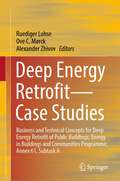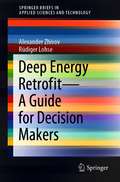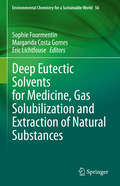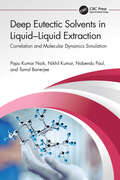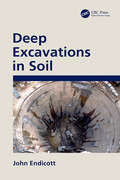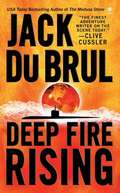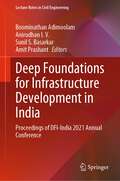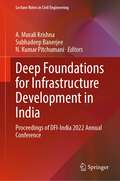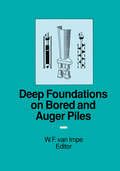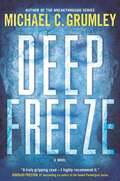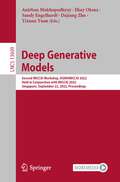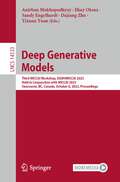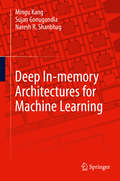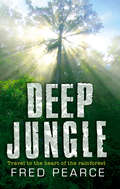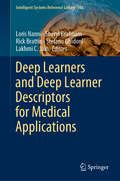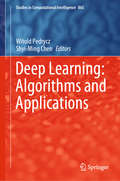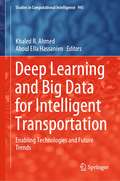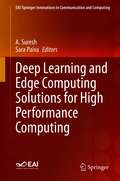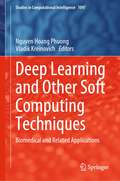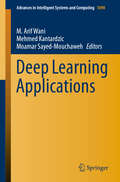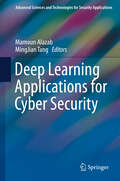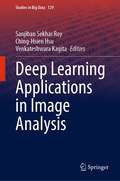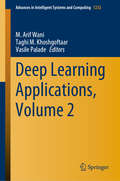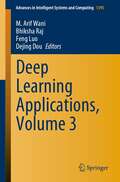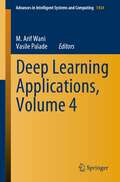- Table View
- List View
Deep Energy Retrofit—Case Studies: Business and Technical Concepts for Deep Energy Retrofit of Public Buildings; Energy in Buildings and Communities Programme; Annex 61, Subtask A
by Ruediger Lohse Ove C. Mørck Alexander ZhivovThis book describes results of research conducted with the goal of providing a framework, selected tools, and guidelines to significantly reduce energy use (by more than 50%) in government and public buildings. The scope of the book is limited to public buildings that were constructed before the 1980s with low internal loads (e.g., office buildings, dormitories, barracks, public housing, and educational buildings) and that were undergoing major renovation. The book contains description and analysis of 26 well-documented case studies from Europe (Austria, Denmark, Estonia, Germany, Ireland, Latvia, Montenegro, The Netherlands, and the UK) and the USA. After these data were collected, the case studies were analyzed with respect to energy use (before and after renovation), reasons for undertaking the renovation, co-benefits achieved, resulting cost-effectiveness, and the business models followed. Finally, “lessons learned” were compiled and compared.Deep Energy Retrofit (DER) is a major building renovation project in which site energy use intensity (including plug loads) has been reduced by at least 50% from the pre-renovation baseline with a corresponding improvement in indoor environmental quality and comfort. Lessons learned from the case studies and experiences of the team clearly indicate that DER can be achieved with the application of “bundles” of a limited number of core technologies readily available on the market. Specific characteristics of some of these core technology bundles generally depend on the technologies available on an individual nation’s market, on the minimum requirements of national standards, and on economics (as determined by a life cycle cost [LCC] analysis).
Deep Energy Retrofit—A Guide for Decision Makers (SpringerBriefs in Applied Sciences and Technology)
by Alexander Zhivov Rüdiger LohseMany governments worldwide are setting more stringent targets for reductions in energy use in government/public buildings. Buildings constructed more than 10 years ago account for a major share of energy used by the building stock. However, the funding and “know-how” (applied knowledge) available for owner-directed energy retrofit projects has not kept pace with new requirements. With typical retrofit projects, reduction of energy use varies between 10 and 20%, while actual executed renovation projects show that energy use reduction can exceed 50%, and can cost-effectively achieve the Passive House standard or even approach net zero-energy status (EBC Annex 61 2017a, Hermelink and Müller 2010; NBI 2014; RICS 2013; Shonder and Nasseri 2015; Miller and Higgins 2015; Emmerich et al. 2011).Building energy efficiency (EE) ranks first in approaches with resource efficiency potential with a total resource benefit of approximately $700 billion until 2030. EE is by far the cheapest way to cut CO2 emissions (McKinsey 2011, IPCC 2007). However, according to an IEA study (IEA 2014a), more than 80% of savings potential in building sector remains untapped. Thus, the share of deployed EE in the building sector is lower than in the Industry, Transport, and Energy generation sectors. Estimates for the deep renovation potentials show: €600-900bn investment potential, €1000-1300bn savings potential, 70% energy-saving potential, and 90% CO2 reduction potential.
Deep Eutectic Solvents for Medicine, Gas Solubilization and Extraction of Natural Substances (Environmental Chemistry for a Sustainable World #56)
by Eric Lichtfouse Sophie Fourmentin Margarida Costa GomesInitially considered as a sub-class of ionic liquids, eutectic mixtures are formed by mixtures of low cost, often biodegradable Lewis or Bronsted acids and bases. Eutectic mixtures have gathered a growing scientific interest by the academic and industrial communities as they are interesting for many applications ranging from metal processing to biomass treatment or pharmaceuticals.This volume gathers contributions by some of the most active research groups in the world using eutectic mixtures for applications in separation, extraction or pharmaceutical and medical applications. The different contributions aim at a large overview of the field for these particular applications by reviewing literature data and presenting ground breaking research in the different fields.
Deep Eutectic Solvents in Liquid-Liquid Extraction: Correlation and Molecular Dynamics Simulation
by Papu Kumar Naik Nikhil Kumar Nabendu Paul Tamal BanerjeeDeep eutectic solvents (DESs) are a new class of green solvents that open a whole new world of opportunities for separation challenges. This book comprehensively provides a detailed discussion of their application as an extractive solvent in separation processes, adopting molecular dynamics (MD) simulations for atomistic insight into the solute transfer across bi-phasic systems. Furthermore, it explains ternary and quaternary mixtures, including MD simulation of relevant DES systems. Features in this volume include the following: Applications of DESs in the extraction of aromatics and polyaromatics from fuel oil by liquid–liquid extraction Eutectic behavior with respect to hydrocarbon and aqueous solutions MD insights on extraction using DESs Possible industrial applicability of potential DESs Results from Gaussian, NAMD, and PACKMOL software packages This book is aimed at researchers and graduate students working in the field of fuels and petrochemicals, separation science, chromatography, and chemical processing and design.
Deep Excavations in Soil
by John EndicottThe book describes the theory and current practices for design of earth lateral support for deep excavations in soil. It addresses basic principles of soil mechanics and explains how these principles are embodied in design methods including hand calculations. It then introduces the use of numerical methods including the fundamental “beam on springs” models, and then more sophisticated computer programmes which can model soil as a continuum in two or three dimensions. Constitutive relationships are introduced that are in use for representing the behaviour of soil including a strain hardening model, and a Cam Clay model including groundwater flow and coupled consolidation. These methods are illustrated by reference to practical applications and case histories from the author’s direct experience, and some of the pitfalls that can occur are discussed. Theory and design are strongly tied to construction practice, with emphasis on monitoring the retaining structures and movement of surrounding ground and structures, in the context of safety and the Observational Method. Examples are presented for conventional “Bottom-up” and “Top-down” sequences, along with hybrid sequences giving tips on how to optimise the design and effect economies of cost and time for construction. It is written for practising geotechnical, civil and structural engineers, and especially for senior and MSc students.
Deep Fire Rising
by Jack DubrulHired to lead the excavation of caverns deep beneath Area 51, Philip Mercer finds himself drilling straight into the epicenterof an age-old conspiracy.
Deep Foundations for Infrastructure Development in India: Proceedings of DFI-India 2021 Annual Conference (Lecture Notes in Civil Engineering #315)
by Boominathan Adimoolam Anirudhan I. V. Sunil S. Basarkar Amit PrashantThis book contains select proceedings of the 10th annual conference of Deep Foundations Institute of India, DFI India, 2021. It presents papers on 1) Geotechnical Investigation, Testing, Instrumentation, Monitoring, and Quality Management, 2) Ground Improvement Techniques, 3) Piling and Deep Foundation Techniques, 4) Earth Retention and Deep Excavation Support, 5) Research, Experimental and Numerical Methods in Deep Foundations and Deep Excavation Technologies, and 6) Safe and Efficient Geo-Construction. This book has seventeen articles, each with a specific field application value. The probabilistic approach in evaluating the field data, namely SPT N and pressure meter modulus for arriving at the geotechnical design parameters, multiphase site investigation program for complex underground construction activity, the safety of working platforms in foundation construction projects, usage of liner piles to support the reaction platform for static loading tests for piles, choice of foundation system for three bridges, emphasis on the importance of selecting an appropriate foundation system for the safe and timely completion of the project, challenges in deep excavations, constructions in confined spaces, groundwater level variations, and their influence on tunneling have been discussed. The usefulness of numerical analysis in the design of deep excavations and ground improvement projects is highlighted. The articles covered in this book are of immense value to professionals and academicians for improving their work practice.
Deep Foundations for Infrastructure Development in India: Proceedings of DFI-India 2022 Annual Conference (Lecture Notes in Civil Engineering #373)
by A. Murali Krishna Subhadeep Banerjee N. Kumar PitchumaniThis book comprises select proceedings of the 11th annual conference of Deep Foundations Institute of India, DFI India 2022, held during 15–17 September 2022 in Tirupati. The conference showcased advancements in deep foundation technologies through articles on research and case histories. The book presents papers on deep foundation and deep excavation technologies for metro and high-speed rail; innovative techniques and testing for geotechnical investigations; monitoring, performance, and the QA-QC of deep foundations; challenges to working and the impact of existing codes with respect to technical innovations in deep foundations; ground improvement techniques for mass stabilization; geotechnics for marine, near-shore, and coastal constructions; research, experimental and numerical methods in deep foundations and deep excavation technologies; mono-piles and other advanced deep foundation systems; deep foundations in coralline and carbonate rocks and other unique and interesting papers related to deep foundation themes.
Deep Foundations on Bored and Auger Piles - BAP III
by W.F. van Impe and W. HaegemanThis text presents findings from the 3rd International Geotechnical Seminar, held in Ghent, Belgium. Topics include: American experiences with large diameter bored piles; case histories; static, dynamic and pile integrity testing; and installation parameters and capacity of screwed piles.
Deep Freeze: A Novel (The Revival Series #1)
by Michael C. GrumleyFrom the bestselling author of the Breakthrough series: In his next near-future thriller, Michael C. Grumley explores humanity’s thirst for immortality—at any cost... “A fast-paced juggernaut of a story, where revelations pile upon revelations, building to a stunning conclusion that will leave readers clamoring for more.” —James Rollins, #1 New York Times bestselling author of the Sigma Force series The accident came quickly. With no warning. In the dead of night, a precipitous plunge into a freezing river trapped everyone inside the bus. It was then that Army veteran John Reiff’s life came to an end. Extinguished in the sudden rush of frigid water. There was no expectation of survival. None. Let alone waking up beneath blinding hospital lights. Struggling to move, or see, or even breathe. But the doctors assure him that everything is normal. That things will improve. And yet, he has a strange feeling that there's something they're not telling him. As Reiff's mind and body gradually recover, he becomes certain that the doctors are lying to him. One-by-one, puzzle pieces are slowly falling into place, and he soon realizes that things are not at all what they seem. Critical information is being kept from him. Secrets. Supposedly for his own good. But who is doing this? Why? And the most important question: can he keep himself alive long enough to uncover the truth?At the Publisher's request, this title is being sold without Digital Rights Management Software (DRM) applied.
Deep Generative Models: Second MICCAI Workshop, DGM4MICCAI 2022, Held in Conjunction with MICCAI 2022, Singapore, September 22, 2022, Proceedings (Lecture Notes in Computer Science #13609)
by Anirban Mukhopadhyay Ilkay Oksuz Sandy Engelhardt Dajiang Zhu Yixuan YuanThis book constitutes the refereed proceedings of the Second MICCAI Workshop on Deep Generative Models, DG4MICCAI 2022, held in conjunction with MICCAI 2022, in September 2022. The workshops took place in Singapore. DG4MICCAI 2022 accepted 12 papers from the 15 submissions received. The workshop focusses on recent algorithmic developments, new results, and promising future directions in Deep Generative Models. Deep generative models such as Generative Adversarial Network (GAN) and Variational Auto-Encoder (VAE) are currently receiving widespread attention from not only the computer vision and machine learning communities, but also in the MIC and CAI community.
Deep Generative Models: Third MICCAI Workshop, DGM4MICCAI 2023, Held in Conjunction with MICCAI 2023, Vancouver, BC, Canada, October 8, 2023, Proceedings (Lecture Notes in Computer Science #14533)
by Anirban Mukhopadhyay Ilkay Oksuz Sandy Engelhardt Dajiang Zhu Yixuan YuanThis LNCS conference volume constitutes the proceedings of the third MICCAI Workshop, DGM4MICCAI 2023, Held in Conjunction with MICCAI 2023, Vancouver, BC, Canada, October 2023. The 23 full papers included in this volume were carefully reviewed and selected from 38 submissions.The conference presents topics ranging from methodology, causal inference, latent interpretation, generative factor analysis to applications such as mammography, vessel imaging, and surgical Videos.
Deep In-memory Architectures for Machine Learning
by Mingu Kang Sujan Gonugondla Naresh R. ShanbhagThis book describes the recent innovation of deep in-memory architectures for realizing AI systems that operate at the edge of energy-latency-accuracy trade-offs. From first principles to lab prototypes, this book provides a comprehensive view of this emerging topic for both the practicing engineer in industry and the researcher in academia. The book is a journey into the exciting world of AI systems in hardware.
Deep Jungle: Journey To The Heart Of The Rainforest
by Fred PearceDEEP JUNGLE is an exploration of the most alien and feared habitat on Earth. Starting with man's earliest recorded adventures, Fred Pearce journeys high into the canopy - home to two-thirds of all the creatures on our planet, many of whom never come down to earth. During his travels he encounters all manner of fantastic flora and fauna, including a frog that can glide from tree to tree, a spider that can drag live chickens into its burrow and a flower that smells of decaying flesh.It is in the jungle that Pearce discovers secrets about how evolution works, the intricate links that connect us all, and maybe even clues to where humans came from - here is the key to our future foods and medicines, our climate and our understanding of how life works. At the start of a new millennium Pearce asks why we continue to waste precious time - and billions of dollars - looking for signs of life elsewhere in our universe when the greatest range of life-forms that have ever existed lies right here on our doorstep. Today environmentalists say we are on the verge of destroying the last rainforests, and with them the planet's evolutionary crucible, and maybe even its ability to maintain life on Earth. But nature has a way of getting its own back. The Mayans and the people of Angkor went too far in manipulating nature and paid the ultimate price. Their civilisations died and the jungle returned. Nature reclaimed it's own and it may do so again ...
Deep Learners and Deep Learner Descriptors for Medical Applications (Intelligent Systems Reference Library #186)
by Loris Nanni Sheryl Brahnam Rick Brattin Stefano Ghidoni Lakhmi C. JainThis book introduces readers to the current trends in using deep learners and deep learner descriptors for medical applications. It reviews the recent literature and presents a variety of medical image and sound applications to illustrate the five major ways deep learners can be utilized: 1) by training a deep learner from scratch (chapters provide tips for handling imbalances and other problems with the medical data); 2) by implementing transfer learning from a pre-trained deep learner and extracting deep features for different CNN layers that can be fed into simpler classifiers, such as the support vector machine; 3) by fine-tuning one or more pre-trained deep learners on an unrelated dataset so that they are able to identify novel medical datasets; 4) by fusing different deep learner architectures; and 5) by combining the above methods to generate a variety of more elaborate ensembles. This book is a value resource for anyone involved in engineering deep learners for medical applications as well as to those interested in learning more about the current techniques in this exciting field. A number of chapters provide source code that can be used to investigate topics further or to kick-start new projects.
Deep Learning: Algorithms and Applications (Studies in Computational Intelligence #865)
by Witold Pedrycz Shyi-Ming ChenThis book presents a wealth of deep-learning algorithms and demonstrates their design process. It also highlights the need for a prudent alignment with the essential characteristics of the nature of learning encountered in the practical problems being tackled. Intended for readers interested in acquiring practical knowledge of analysis, design, and deployment of deep learning solutions to real-world problems, it covers a wide range of the paradigm’s algorithms and their applications in diverse areas including imaging, seismic tomography, smart grids, surveillance and security, and health care, among others. Featuring systematic and comprehensive discussions on the development processes, their evaluation, and relevance, the book offers insights into fundamental design strategies for algorithms of deep learning.
Deep Learning and Big Data for Intelligent Transportation: Enabling Technologies and Future Trends (Studies in Computational Intelligence #945)
by Khaled R. Ahmed Aboul Ella HassanienThis book contributes to the progress towards intelligent transportation. It emphasizes new data management and machine learning approaches such as big data, deep learning and reinforcement learning. Deep learning and big data are very energetic and vital research topics of today’s technology. Road sensors, UAVs, GPS, CCTV and incident reports are sources of massive amount of data which are crucial to make serious traffic decisions. Herewith this substantial volume and velocity of data, it is challenging to build reliable prediction models based on machine learning methods and traditional relational database. Therefore, this book includes recent research works on big data, deep convolution networks and IoT-based smart solutions to limit the vehicle’s speed in a particular region, to support autonomous safe driving and to detect animals on roads for mitigating animal-vehicle accidents. This book serves broad readers including researchers, academicians, students and working professional in vehicles manufacturing, health and transportation departments and networking companies.
Deep Learning and Edge Computing Solutions for High Performance Computing: High Performance Computing And Emerging Healthcare Technologies (EAI/Springer Innovations in Communication and Computing)
by A. Suresh Sara PaivaThis book provides an insight into ways of inculcating the need for applying mobile edge data analytics in bioinformatics and medicine. The book is a comprehensive reference that provides an overview of the current state of medical treatments and systems and offers emerging solutions for a more personalized approach to the healthcare field. Topics include deep learning methods for applications in object detection and identification, object tracking, human action recognition, and cross-modal and multimodal data analysis. High performance computing systems for applications in healthcare are also discussed. The contributors also include information on microarray data analysis, sequence analysis, genomics based analytics, disease network analysis, and techniques for big data Analytics and health information technology.
Deep Learning and Other Soft Computing Techniques: Biomedical and Related Applications (Studies in Computational Intelligence #1097)
by Nguyen Hoang Phuong Vladik KreinovichThis book focuses on the use of artificial intelligence (AI) and computational intelligence (CI) in medical and related applications. Applications include all aspects of medicine: from diagnostics (including analysis of medical images and medical data) to therapeutics (including drug design and radiotherapy) to epidemic- and pandemic-related public health policies.Corresponding techniques include machine learning (especially deep learning), techniques for processing expert knowledge (e.g., fuzzy techniques), and advanced techniques of applied mathematics (such as innovative probabilistic and graph-based techniques).The book also shows that these techniques can be used in many other applications areas, such as finance, transportation, physics. This book helps practitioners and researchers to learn more about AI and CI methods and their biomedical (and related) applications—and to further develop this important research direction.
Deep Learning Applications (Advances in Intelligent Systems and Computing #1098)
by Moamar Sayed-Mouchaweh Mehmed Kantardzic M. Arif WaniThis book presents a compilation of selected papers from the 17th IEEE International Conference on Machine Learning and Applications (IEEE ICMLA 2018), focusing on use of deep learning technology in application like game playing, medical applications, video analytics, regression/classification, object detection/recognition and robotic control in industrial environments. It highlights novel ways of using deep neural networks to solve real-world problems, and also offers insights into deep learning architectures and algorithms, making it an essential reference guide for academic researchers, professionals, software engineers in industry, and innovative product developers.
Deep Learning Applications for Cyber Security (Advanced Sciences and Technologies for Security Applications)
by Mamoun Alazab MingJian TangCybercrime remains a growing challenge in terms of security and privacy practices. Working together, deep learning and cyber security experts have recently made significant advances in the fields of intrusion detection, malicious code analysis and forensic identification. This book addresses questions of how deep learning methods can be used to advance cyber security objectives, including detection, modeling, monitoring and analysis of as well as defense against various threats to sensitive data and security systems. Filling an important gap between deep learning and cyber security communities, it discusses topics covering a wide range of modern and practical deep learning techniques, frameworks and development tools to enable readers to engage with the cutting-edge research across various aspects of cyber security. The book focuses on mature and proven techniques, and provides ample examples to help readers grasp the key points.
Deep Learning Applications in Image Analysis (Studies in Big Data #129)
by Sanjiban Sekhar Roy Ching-Hsien Hsu Venkateshwara KagitaThis book provides state-of-the-art coverage of deep learning applications in image analysis. The book demonstrates various deep learning algorithms that can offer practical solutions for various image-related problems; also how these algorithms are used by scientists and scholars in industry and academia. This includes autoencoder and deep convolutional generative adversarial network in improving classification performance of Bangla handwritten characters, dealing with deep learning-based approaches using feature selection methods for automatic diagnosis of covid-19 disease from x-ray images, imbalance image data sets of classification, image captioning using deep transfer learning, developing a vehicle over speed detection system, creating an intelligent system for video-based proximity analysis, building a melanoma cancer detection system using deep learning, plant diseases classification using AlexNet, dealing with hyperspectral images using deep learning, chest x-ray image classification of pneumonia disease using efficient net and inceptionv3.The book also addresses the difficulty of implementing deep learning in terms of computation time and the complexity of reasoning and modelling different types of data where information is currently encoded. Each chapter has the application of various new or existing deep learning models such as Deep Neural Network (DNN) and Deep Convolutional Neural Networks (DCNN). The detailed utilization of deep learning packages that are available in MATLAB, Python and R programming environments have also been discussed, therefore, the readers will get to know about the practical implementation of deep learning as well. The content of this book is presented in a simple and lucid style for professionals, nonprofessionals, scientists, and students interested in the research area of deep learning applications in image analysis.
Deep Learning Applications, Volume 2 (Advances in Intelligent Systems and Computing #1232)
by M. Arif Wani Taghi M. Khoshgoftaar Vasile PaladeThis book presents selected papers from the 18th IEEE International Conference on Machine Learning and Applications (IEEE ICMLA 2019). It focuses on deep learning networks and their application in domains such as healthcare, security and threat detection, fault diagnosis and accident analysis, and robotic control in industrial environments, and highlights novel ways of using deep neural networks to solve real-world problems. Also offering insights into deep learning architectures and algorithms, it is an essential reference guide for academic researchers, professionals, software engineers in industry, and innovative product developers.
Deep Learning Applications, Volume 3 (Advances in Intelligent Systems and Computing #1395)
by M. Arif Wani Bhiksha Raj Feng Luo Dejing DouThis book presents a compilation of extended version of selected papers from the 19th IEEE International Conference on Machine Learning and Applications (IEEE ICMLA 2020) and focuses on deep learning networks in applications such as pneumonia detection in chest X-ray images, object detection and classification, RGB and depth image fusion, NLP tasks, dimensionality estimation, time series forecasting, building electric power grid for controllable energy resources, guiding charities in maximizing donations, and robotic control in industrial environments. Novel ways of using convolutional neural networks, recurrent neural network, autoencoder, deep evidential active learning, deep rapid class augmentation techniques, BERT models, multi-task learning networks, model compression and acceleration techniques, and conditional Feature Augmented and Transformed GAN (cFAT-GAN) for the above applications are covered in this book. Readers will find insights to help them realize novel ways of using deep learning architectures and algorithms in real-world applications and contexts, making the book an essential reference guide for academic researchers, professionals, software engineers in the industry, and innovative product developers.
Deep Learning Applications, Volume 4 (Advances in Intelligent Systems and Computing #1434)
by M. Arif Wani Vasile PaladeThis book presents a compilation of extended versions of selected papers from 20th IEEE International Conference on Machine Learning and Applications (IEEE ICMLA 2021). It focuses on deep learning networks and their applications in domains such as healthcare, security and threat detection, fault diagnosis and accident analysis, and robotic control in industrial environments. It highlights novel ways of using deep neural networks to solve real-world problems, and also offers insights into deep learning architectures and algorithms, making it an essential reference guide for academic researchers, professionals, software engineers in industry, and innovative product developers. The book is fourth in the series published since 2017.
